
The tuna is the completion of a vision that I had the first moment I saw Jake ride that first faithful wave an alaia in 2005, "Oh my god, you don't need a fin!!!" Tom Blake put fin on a surfboard in 1936 but they did not really become a necessary part of surfboards for almost a generation. Could we have lost something special when we abandoned the finless surfing some time in the late 1950s?
Jacob Stuth and I spent two years developing the alaia. At first it was not really all that beautiful for the normal observer. We did not make lots of easy waves and there were endless swims to the beach. But we felt a fire with the board. The feeling of frictionless trim was intoxicating. We couldn't get it out of our heads even though the boards had problems. They could not handle a steep face, they could not take chop, they were very difficult to catch a wave with and they were exhausting to paddle. But glide was worth the work and frustration.
Jake and I were inspired by the ancient Hawaiian legends of surfing and knew that the answers were out there. The Hawaiians surfed the most challenging waves in the world on wood surfboards. We can do it too!!!
After three years we had figured it out. We were getting tubed and cutting back on our shorter more flexible alaias. Great surfers like Tom Carroll, David Rastovich, Tom Curren, Dan Malloy, Rob Machado, Harrison Roach, Mike Stewart... were riding them and a wave of alaia stoke went around the world. Four years after Jake's first wave, I travelled through Europe and was greeted by the local alaia riders where ever I went. In Spain, France, UK, and Ireland there were riders. In Japan there were contests for alaias. In Hawaii the Buffalo contest had a very hotly contested alaia division. In California most good surfers had one in their quiver. The respect for the ancient Hawaiians surfing was corrected. David Rastovich proved the ancient legends true when he made a late drop at Wiamea Bay on a flat piece of wood. I was named "2009 Shaper of the Year" by surfing magazine. The alaia had been re-established as a great surfboard.
But, the alaia still had one problem that was nearly critical to the vast majority of surfers in the world. They are very hard to paddle and catch a wave with. You can easily ride kick out with flippers on and ride them prone, which is GREAT fun, but for surfers who want to stand up, the struggle is deflating. Personally, I was falling short on the paddling end early on. At 43 years old, I could not keep up with the kids. I got tired easily. I would get a few fantastic rides on the alaia and then go in and grab one of my bigger boards and get lots of waves.
One of my favourite boards was a 16 foot Bill Wallace Toothpick. It is light and catches anything. It is finless so it has the speed across the wall and can sideslip or "La la" when the wave is right. I began to wonder whether I could mix the control of the alaia with the speed and ease of paddling with the toothpick.
The obvious solution to getting more waves on the alaia was to make a longer alaia. I made lots of them climaxing with a 12 footer that is in Herritage surfboards, Manly. Another 12 footer featured in Musica Surfica and was then was cut down numerous times and featured again in the movie, "The Present" under the feet of Rob Machado as his 5'7" peanut. The fact is that the longer the alaia, the harder is to paddle and to catch a wave. Shorter, around your own height, is the best length for an alaia. And, of course, this is the length of the alaias described by Hawaii's first chroniclers.
In 2008 I was working with Mike Stewart on a prone alaia and he had been thinking about how to make a finless stand up surfboard. He obviously knows a lot about rails and sticking into waves. He came to visit me and we had a great few days talking design and making a new style board. He designed an alaia with round rails glued to the side. It was like two peppers stuck on the sides of a tortilla chip. I didn't have much hope for the board because I thought that it would loose its flex. Well, we got some small waves and Harrison Roach came to give it a try and it worked fine. Harrison and Matt Williams said it felt just like a twin fin on the wave. Harrison still rides the board two years later.
This experience started a new little fire in me. Wow, It seems possible to make a floating, easy paddling finless board that rides just like a finned board. I had an idea, I would put some round football shaped fins on the bottom of a cut down hollow toothpick. They would just hold the tail in the water so it would not skip out when the wave got too steep. The fins were the exact shape of a tuna's body, almost round instead of flat like a fin.. They were not really fins, they just went on the bottom of the board at the tail. I called this the "Tuna Project” because of the tuna shape of the fins. To test the tunas I made a very basic hollow kook box, 9 feet long, 21 inches wide and 3 inches thick.
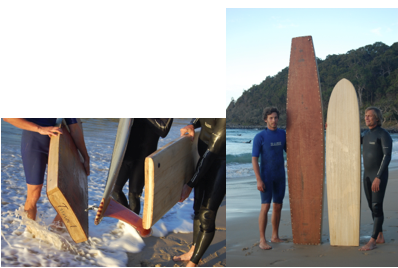
A kook box refers to the most rudimentary hollow boards of the 1940's and 50's. They had a plywood deck and bottom with vertical rails and little rocker. They were much lighter than the solid slabs popular at the time, but lacked control and they usually leaked. I think the term was used as a ribbing to the home made boards that lacked carpentry skills. My kook box definitely fit that description. I bought screws with flat heads to use on the board but I forgot them at the hardware store so I used any screw that I could find in the shed. It looked like it would tear your privates badly if you were not careful. The board was embarrassing looking with a square nose, cheap plywood, haphazardly placed un-matching screws, and spilled epoxy from filling the leaks.
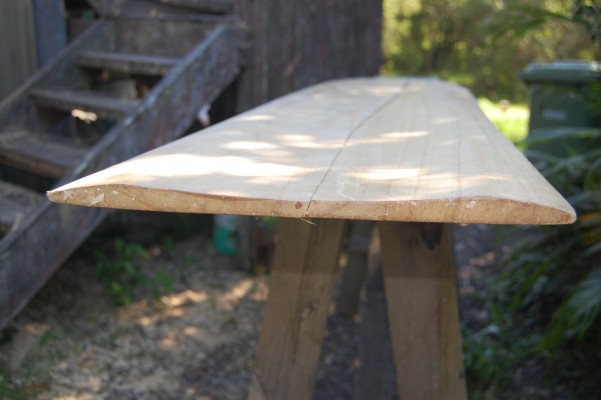
But, the board had a very advanced bottom curve through the tail.
I decided to put an exaggerated "Rasta" concave on the bottom along with boogie board rails. I call this bottom the Rasta because his board was the first of this exaggerated concave between two roles design.
I went to Tea Tree for the maiden voyage and it worked great. The tunas were screwed to the bottom of the board. The board would take off across a swell and would la la when the wave got steep, but then the tunas held the tail in after the slide and the board resumed trim. They were good. Then I took them off to try the board without them. The first wave surprised me with how light the board felt. It went fast and was easy to control. Then I waited a long time for a head high set and the board filled up with water. The wave came and I was very lucky to have paddled into it. The board took off down the line like it was possessed. There was a guy looking at me like I was not going to make it, so he kept paddling it. The speed I was feeling was only reminiscent of the Olo with acceleration increasing beyond anything you can feel on a light board. The guy saw the square nose of the tuna coming at him way faster that he could have imagined and a heartbeat later I would have crushed his board like an egg carton. But, I leaned on the outside rail and the board slid down the face in the la la and I went around him like he was standing still. I came in with the feeling that this was a really good board. It handled a tough situation well with 20 kilos of water inside. The board became an enigma to me. It was not meant to be a surfboard. It was totally experimental to test the tuna fins, but it was I surfed more than any other board for several months. Here was the sign post to somewhere, but I did not know.
Next I made a seven foot tuna. The name stuck with the board though the fins were abandon. It was nice because it paddled well and trimmed on a fat wave, but I could not get it to hold in to a steep section. David Rastovich rode it at the pass on a lumpy head high afternoon and he liked it. I watched him make long sections and he could hold into a steep face, but he looked a lot better on the alaia. Then Derek Hynde got one really good wave on it at nationals. He looked great and I thought he was going to say "Wow!!!" when he pulled out. But he went strait to shore and said he enjoyed it but he is off to get his board. The board was almost there. It worked but it did not have the spark that makes a board great. I put it aside for a year. I knew that the problem was flex. Without flex, the short finless board can't grab into a wave and jump out of a turn.
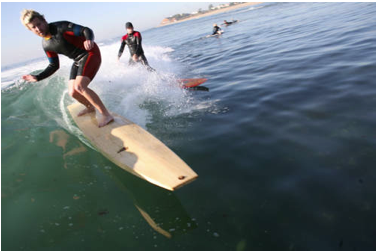
I turned my efforts to making the tuna longer. I was going to California for the 2008 Sacred Craft show in San Diego and wanted to take a tuna to show my brother, Jon. It was 10 feet, thick and light. I couldn't believe that Matt and waltzed through customs with huge board bags on a beautiful Santa Ana condition California day. From the plane we could see that it was glassy with a nice south swell. Jon, was waiting for me frothing on the surf. The boards were strapped on in record time and we were zipping off to Malibu. Coming around Topanga I could see we were in for a treat, but I realized that I had forgotten a bung for the new tuna. We pulled over at a liquor shop and I bought a bottle of wine and a corkscrew. A bunch of people were glued to the TV in there and watching the breaking news of the financial crisis. It was melancholy. I didn't know how hard it was hitting in the US. We got to Malibu and it was the best Malibu I had ever seen; sheet Glass, head high sets, and a very light crowd. In a flap I spilled the open bottle of wine all over my brother’s car. But the cork fit the bung and we were off. Out of all the boards we had, including a brand new oiled wood nose rider, all I wanted to ride was the Tuna. Soon it had caught the attention of the locals that I had not surfed with in over a decade. Trace Marshall grabbed it and would not give it back. He was trimming and cutting back beautifully. This was a winner. He ended up buying it and it will feature with him in the next Jack McCoy movie. But, at the Sacred Craft show the tuna was in the corner of our booth and it went completely unnoticed.
On the way back to LA Matt and I stopped to see Tom Morey. He is a hero of mine and I wanted to personally thank him for his numerous contributions to the surfing world. I wanted to show him my alaias and the tuna. I especially thanked him for inventing the boogie board vacuum rail which I used on the Tuna. He is a beautiful man and soon warmed to us. He looked at the alaia and couldn't imagine that it was actually a surfboard. But he liked the tuna. He said that when he was on the Big Island he began experimenting with foam body boards and looked to the V bottom on the hot curl for inspiration. He put a V on each rail and the board held in just fine. Tom is second to none in surfing designs.
For my 44th birthday, March 5, 2009, I made a 12 foot tuna. It was longer and narrower for the points. I put a little bit of tail rocker on it in hopes of being able to cut back and having the tail slide as the board arched around. It worked in small surf although it was stiff to turn, but in bigger surf the tail definitely slid out along with the rest of the board and me. A really big clean swell came in and I was dying to ride it. The surf was clean but it was actually treturous with lots of water moving. It was not crowed though and I had room to try the board. I lost the board a few times and once it went over a guy being dragged down the point by his leash. He was screaming at me as I pulled a substantial portion of his destroyed board out of my rail on the shore. "You are dangerous out there with that thing!!! How come you don't have a leash? You could have killed me!!!" I don't know if I am right or wrong. I think it is the law of the jungle in the water. If you want to be safe, don't surf on the biggest day. Swim between the flags. All this is true until my board hits a little kid. Then I am wrong; no theoretic arguments (this never happened and I will never let it happen), but this guy storms off with a head full of rage. I fill my big hole with a bar of wax and paddle back out.
This is very important to my development of the new Tuna. Safety in the water is a big factor. We have to be considerate to others and be as safe as we can. As I floated outside the perfect line up, my board quickly filling up with water, I reflected on an experience that happened to me at Waikiki four years earlier.
My family and I went to Waikiki to ride our wood boards just like Tom Blake and the Duke. At the Crack of dawn Margie and I would slip out and get the first waves. Margie on her 10 foot Model A and me on the 12 foot Sunday. We surfed Canoes until the crowd came and then put our boards in the beach board rack and went back up to my parents who were attending our the our kids. (We were very lucky to have spaces in the board rack as well as parents along!). On our last day Donald Takayama and Rabbit Kekie came down to look at the boards and catch up. (Donald is a good friend and I was a team rider for 10 years). After a while some of the true Waikiki elders came down to talk. They told me many stories of wood boards and surfing with the Duke and others. They spoke of the day they were all out surfing Queens when Pearl Harbour was attacked. They told me of a guy who made boards exactly like mine 40 years earlier but out of pine. I was on top of the world when things went a little cold. The elder turned to me and said that I may not surf here on my wood boards any more. They are too dangerous. There are girls and kids out there and even with a leash, a lost board is very dangerous. There is no need for these boards any more. The light boards are safer. Wow. I was dumb struck. But these guys are the true elders. I agreed with their request and said I will take heart to what they said.
I brought this event up to another hero of mine, George Greenough. He largely agreed. Surfboards should be safer. The pointed noses are more dangerous than good. He stressed that safety is important. (One important note: When I made the first alaia, I asked George if it is possible to do a bottom turn with a finless stand up surfboard. He said of course. He was the only one).
During the development of the tuna, I am a man in two places. When surfing the big tunas, toothpicks, and 12 plus finned boards, I am outside the line-up catching any wave I want yet I am always concerned that my board may injure someone. But most of the time I am sinking on the inside of the pack on a thin alaia. With the nominal buoyancy of the alaia I am going under the sets as people surf over the top of me. Catching a wave is infinitely more difficult on an alaia and people paddle around me like I am a piece of trash. It is the law of the jungle out there. Not too many people are concerned about my safety or happiness. I really care about the dignity of other surfers but it is not reciprocated. This conundrum torments me.
In the days of the ali'i in ancient Hawaii, only the royalty could ride the big boards and when they paddled out everyone else went in. I understand that order now.
The shortboard revolution taught us one thing; the guy on the longest board gets the next set wave, and if he is a grade B surfer on a surftech, he will be ruthless.
In the end, the rule probably is: If you don't want to get hurt by a big board, go to the beach when they paddle out. If you ride a big board you better be a good surfer, or be ready to deal with the moral issue of unintentionally letting someone get clobbered by your board.
Why can't I ride a normal board? Should we all ride the same boards like we did in the mid 1970's? Should we all ride what the top 44 are riding? Is surfing a sport where we all have to abide by the same rules like we do on the football field? Or is surfing the oldest practiced sport on earth with huge diversity that we are still grappling to understand?
In California my friends Cyrus Sutton, Ryan Birch and Rob Machado were also finding the alaia a bit too strenuous to surf often and started looking to foam to make a floaty alaia. They were taking EPS foam blanks and just cutting out shapes and surfing them. I was so impressed and I quizzed Cyrus on the boards. He said they are fun but very tricky to ride and they break easy.
In the northern summer of 2009, the alaia wave has crested and I jump on a plane to Europe to ride it. I sent 70 alaia blanks to Bilbao, Spain with plenty of orders to fill. After 7 weeks my family comes over and I have a wad of cash that I could hardly fit past my teeth. We travel around Spain, France, UK, and Ireland observing the surf culture. I am surprised to see an acceptance finless surfboards. For example, in Newquay the local lifeguards had taken the fins out of the rental foamies and were ripping. I also see an impressive volume of young beginner surfers. I notice the kids trying to bust airs before they can draw a line. They are trying to rip on a bicycle with training wheels that they may never take off. I realized that the alaia was a nitch board for the core surfer but a good floating alaia was the next generation. The surf is so crowded over there in the summer that it boggles the Australian mind. All those fins and pointy noses piled up on a jumbly peak just churns my guts. I couldn't surf in that mess and I expected carnage with every set.
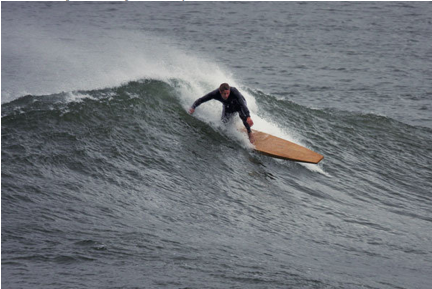
While we were in Ireland, I rode an 8 foot tuna that I made from plywood and scraps from the alaias. I had tuned my thoughts a lot and made a much better tuna than before. It had the spark that number 2 - the 7 footer - was missing. The board was light and so flimsy that it could twist and bounce out of a turn. It felt like flexible alaia.
I came back to Australia with a purpose, I had to make an alaia that floats and paddles well. The alaia is the best board when surfing on the wave. The exhilaration is breathtaking. All of my friends agree that just standing in trim on an alaia is equal to perching a perfect 10. The alaia tube rides better than a finned board in regular sized waves (proven) and is faster. You can do the sickest cutbacks way out on the shoulder and accelerate all the way through. The alaia is a frontier all to its own. The thruster majority are ripping, yes, for sure, but they have a full generation of thruster riding behind them. Their dad's rode almost exactly the same board. The new finless crew are basically reinventing it all with new materials.
I was focussed again on the tuna shape, but much shorter like an alaia. My brother, Jon had already made a foam semi finless board called a Bluegill (after a very nice freshwater fish) The Bluegill has a twin fin set up, but the fins aren't really fins. They are 1 inch high and 8 inches long. They are just enough to keep the tail from sliding but not interfering with the alaia feel. On a totally independent line, Sage Joske is making a similar board on the Gold Coast and calling it a Vector. The boards ride great and we are all on the same trip, to make an alaia that paddles easily.
I know where Jon and Sage are coming from, but I think I can get the "grab" the board needs not from a bit of fin but from flex. My first mini-tuna I made from a regular foam blank with wood rails and a light glass job. The hope was that the wood on the rails will flex into the wave giving the alaia grab. It worked good for a first try. It was fast and cut back, but looses it in a steep wave. Next I make a 7'7" with the same design. It is super fun in tiny or soft waves but slides out in steep surf as well.
In the back of my mind I have known the answer to flex and pop, but I have been avoiding it because it is in the too hard basket. Also, it does not fit in with my green, home made approach, but it is the best solution by far. On my mission statement the number one objective is to make the best surfboards, not the greenest. The answer is.......
EPS foam and epoxy.
In 1985 I was in Carlsbad, California making a few boards when a guy asked me to shape boards for his label. I shaped few longboards for him and he gave me an EPS board that he had blown out of his plug. The board popped. It jumped out of turns. It felt like a new Clark Foam board all the time. Clark Foam was shit and his lousy demise was one of a few acts of justice. When I first got the flex right on the alaias I though, "Gee, that feels like my old EPS minimal". I liked the stuff so much that I wandered Mexico City in 1987 looking at EPS foam moulding to make surfboards. I finished my degree in law instead.
I needed good EPS foam for the boards and I knew where to go. I have been friends with Mark Kelly at Global Surf Industries for several years now. GSI sponsors the Noosa Surfing Festival and I prostate myself to him thanking him for this and for supporting the few longboard magazines. I don't do this as a pose. I really respect Mark for saying that "Life is better when you surf". The more I travel and see happy faces in the water, the more I love surfing.
So Mark Kelly has 12 big, fat longboard EPS foam blanks sent to my house and Matt and I go to town. We have high hopes of shaping all of them soon. I shape a seven boards from 4'11 to 6'2" . Even before the glassing stage I take the 5'3" out for a surf. I just want to feel the flex of the foam and the buoyancy. I need to match up length with buoyancy. Will it float enough? The smaller the better, so long as you can stroke into a wave, that is all the buoyancy you need. Any more will hinder the ride. Bingo! the 5'3" is all that I hoped for. I could paddle, duck dive, and pull into a steep section without side slipping at all. Then I broke the nose off.
I start glassing all the boards with epoxy and things start going wrong. (I have glassed many hundreds of polyester boards). Even though I have the gear on, I get a rash from the fumes. Epoxy, like many common industry chemicals of today, needs special ventilation and safety procedures that come with professional use. It is not for backyarders like me. Eventually, we get the boards done.
Out of nowhere a surfer named Isaac shows up. He moved to Noosa to surf and stocks shelves at the IGA at night to fund his goal. He is a real surfer. I toss him the prototypes and he surfs them the way I dream. He comes to my factory to bash out surfboards. Matt, Isaac, and fat old me hashed out the essential elements of the EPS mini tuna. With rigidity you gain speed. With flex you get control, but you will end up with a broken board soon. There are lots of other factors: the steepness of the vacuum boogie board rails, the depth of the concave, the roll in the nose (extremely important), the strait vs. round vs. concave tail template, the weight... We make 8 EPS, 5 hollow wood, and 4 surfboard foam tunas to get a real understanding of how the roles, the edge, and the flex work together to make the magic tuna. (This was a very costly exercise and I am so lucky to still have a loving wife and house after this chapter)
The really big mystery we had to solve was how to make a tuna that would rip a cut back. That was the holy grail. My old school thinking is still moulded in a fin pushing against water to allow you to change direction at speed. The alaia and the tuna don't have fins, only a sharp edge on the rail, a very slight convex roll on either side of the board and flex. Can this combination displace enough water for the rider to push out of a turn and cut back? It is silly for me to think like this because I saw David Rastovich do exactly this two years earlier. But, I still don't completely know why it works and I am not entirely confident that it can translate over to a foam board. The foam cannot have the flex of thin paulownia wood. It does not have the super slick oiled surface of the wood so it is inherently slower (oiled wood is really that much faster than foam). But with the foam I have a thicker board with the vacuum rails that really do hold the board in on a steep face.
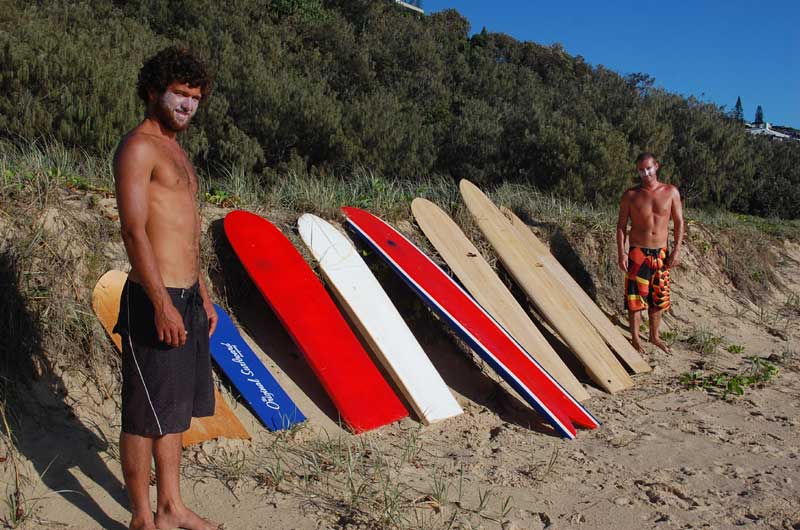
The 2010 Noosa Festival has a finless surfing exhibition as a part of the opening ceremony and the surf was perfect!!! The contest area was essentially the last and most hollow section of a perfect wave that started at least 500 meters up the Noosa Nationals Point. The current was ripping which is not alaia friendly. The riders would get a wave and then take a bit of a swim to shore and a long run up the point to do it again. Harrison Roach was clearly the stand out getting some clean 360 off the lips, but Isaac got the lion's share of the waves. With the foam board, he could paddle out to sea and around the current. I saw that the foam alaia was a workable compromise with the alaia. In the middle of the display cut back and threw a spray that stopped time. It just looked unnatural and definitely unexpected. He just displaced so much water and tore the top off the wave! How did that happen? Yes, it can work.
The tuna is the safest board by far for both the surfer and others. They are super light and don't get enough inertia to really hurt someone. They don't have knives on the bottom of the board or a spear tipped point. In a crowd you can run over your buddy no worries. You can wrap yourself up with you board in a tube and not worry. You can focus more on surfing and less on safety.
I am elated beyond compare when I sign the deal with GSI. They will license two tuna shapes
off me and I will make a royalty. I am full of beans on this project. I feel this shape will
be surfed by thousands of people all around the world. Everyone will be able to get their
hands on a very good finless surfboard for a reasonable price. I have made many surfboards but
very few surfers have ever actually touched one of them. This was a way to share my shapes
with a much wider audience.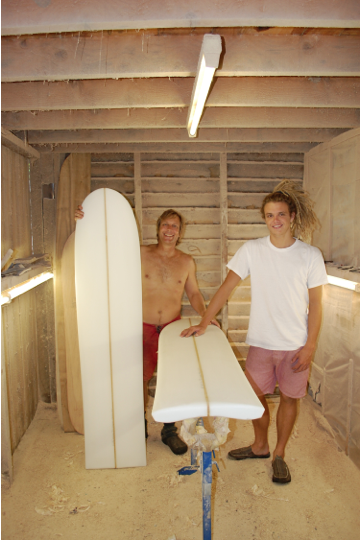
I stand in my shaping shed with two blanks ready to be shaped into the master for the GSI project. The concepts and rules of water flow are boiling in my head. From the prototypes of foam tunas, 15 wood tunas, and about 350 alaias, I am confident, but just. I draw the templates conservatively, basically sticking to the guy in photo from Hawaii. I can make the concave deep because the foam allows a lot of leeway. The rocker is very flat. The questions are how steep do I make the rails? I want them more towards 50 degrees in the tail and then getting more vertical towards the middle. This lets the tail grab at lower speeds and the mid section to grab at higher speeds as you put your weight forward. But, how should the top of the rail be? How far up should the edge go to the nose? How thick should it be to get just the right flex and floatation? All of these questions come to mind. I shoot for the middle ground and make sure what I do know is right. It takes days to shape the two boards.
Weeks later the first prototypes come back and they have to be refined. A month later the next batch are not perfect either. But then, Bingo!!!! They are perfect!!! Isaac and I take a road trip to test the boards in lots of conditions. They pass the test.
On July 28th, 2010 we have the global launch in Sydney and the world braces for the Tuna.
The Albacore
![]() After all the work going into the Tuna there was one
more big step. GSI had discussed the soft version of the Tuna and it was time to focus in on
this board. I could not shape prototypes because they are soft, boogie board material and I
do not have the equipment to make them. I worked off the computer with GSI to design this
board. I made it wider than tuna and 5’3. The first prototypes came back and I could not
fault them. I tried them in all sorts of condition and they were just perfect. From all the
work I had done I was confident with designing them on a computer. The 4’11 prototype came
back and it was perfect as well. It surfed exactly like the board I had felt in my mind.
After all the work going into the Tuna there was one
more big step. GSI had discussed the soft version of the Tuna and it was time to focus in on
this board. I could not shape prototypes because they are soft, boogie board material and I
do not have the equipment to make them. I worked off the computer with GSI to design this
board. I made it wider than tuna and 5’3. The first prototypes came back and I could not
fault them. I tried them in all sorts of condition and they were just perfect. From all the
work I had done I was confident with designing them on a computer. The 4’11 prototype came
back and it was perfect as well. It surfed exactly like the board I had felt in my mind.
In July, 2012 the Albacores were released in the USA and in Europe. They sold out quickly in Europe and did OK in the States. When they came to Australia they sold out in two weeks. That made feel fulfilled. The Seaglass Project has been a very long journey!
I spent a year riding the Albacore and I was getting better at finless surfing. Then I hoped back on the alaia and I could surf it far better than I could before. Then I rode the Tuna and I surfed it better as well. Although riding the albacore is much easier than the other finless boards, it helps learn to use your rails and feel confident. This flows over to the other boards and all of your surfing.